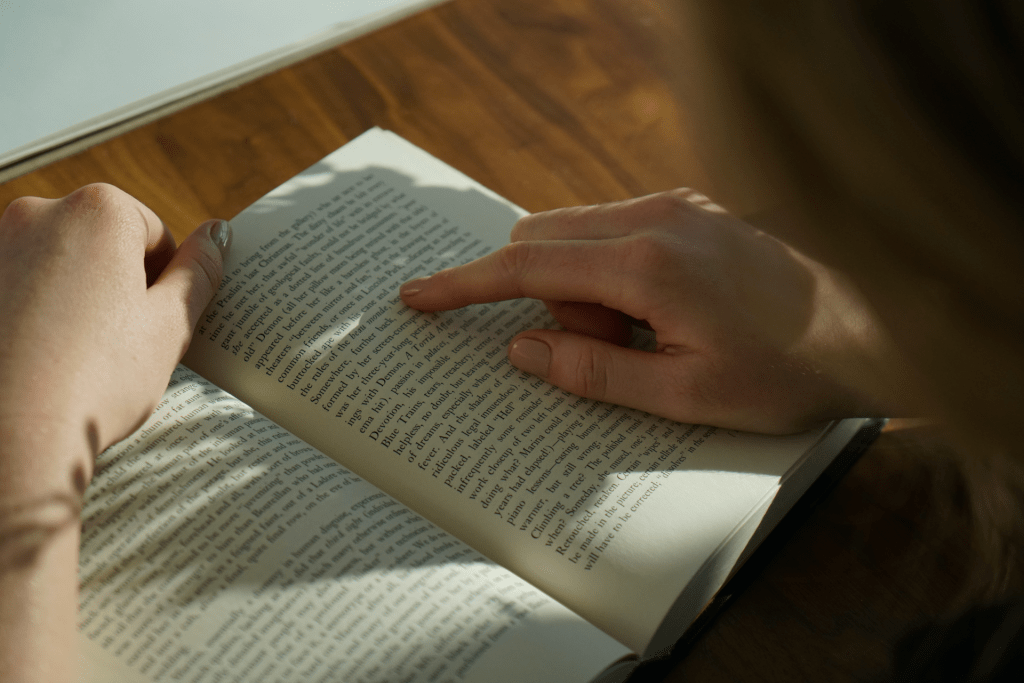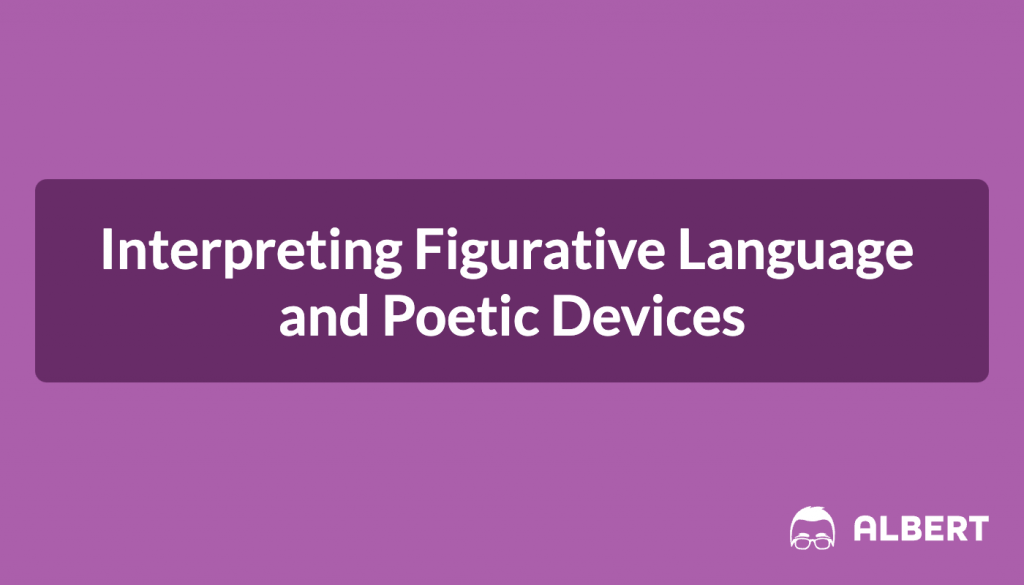What is Figurative Language?
Figurative language can be described as the secret sauce in the recipe of literature. It’s a way of using words that steps beyond their literal meanings and presents ideas or feelings in an imaginative and thought-provoking way. You might find this a bit complex, but in reality, you’ve come across figurative language often. Have you heard expressions like “it’s raining cats and dogs” or “I could eat a horse”? These are examples of idioms and hyperbole, which are forms of figurative language.

Figurative language’s goal is to break away from the everyday and ordinary, and to invite readers into a vibrant world of meaning. It enhances writing by creating layers of depth, constructing vivid imagery, stirring emotions, and offering a unique viewpoint.
Figurative language comes in many shapes. Similes, metaphors, personification, hyperbole, symbolism, and idioms are some of the common types. For example, a metaphor like “life is a roller coaster” draws a comparison between life and a roller coaster, suggesting that life, much like a roller coaster, is full of ups and downs, and twists and turns.
By learning to understand and interpret figurative language, we can dive deeper into the layers of a text and fully appreciate the richness of the author’s vision.
Why Do Authors Use Figurative Language?
Authors use figurative language because it helps them express big ideas in exciting and creative ways. It’s similar to how a painter uses different colors and brush strokes to make an unforgettable painting. Here’s why authors often use figurative language:

- Building Pictures: Figurative language helps create strong images in the reader’s mind. Saying “the forest was so quiet you could hear a leaf drop” is much more powerful than simply saying “the forest was quiet.”
- Sharing Tough Ideas: Figurative language can make tricky or abstract ideas easier to understand. For example, saying someone has a “heart of stone” tells us quickly that they’re cold and don’t show their feelings.
- Sparking Feelings: Figurative language can stir up strong feelings in readers, making them feel more connected to what they’re reading.
- Making Writing Fun: Just like spices make food tastier, figurative language makes writing more fun to read and more memorable.
- Showing Creativity: Figurative language lets authors show their creativity by putting their own spin on how they describe people, places, and things.
The next time you read a book or a poem, look for examples of figurative language. Think about what the author might be trying to say with these expressions and how they add to the story. This can help you enjoy what you’re reading even more and appreciate the skill that goes into writing.
Examples of Figurative Language
To understand the different types of figurative language better, let’s look at some examples you might see in books, songs, or even in everyday conversation:
Simile
A simile is a comparison between two different things that share some common aspect. In the simile “She’s as busy as a bee,” we’re comparing a person (in this case, “she”) to a bee.
Bees are known for their constant activity; they are always moving, flying from flower to flower, collecting nectar, pollinating plants, and producing honey. Because of this, we often use bees as a symbol of busyness or industriousness. When we say “she’s as busy as a bee,” we mean that she is very active and hard-working, similar to how a bee is always working.
So, the simile “She’s as busy as a bee” is saying that the person is extremely busy, just like a bee. The words “as…as” are used to make the comparison, which is a classic way similes are formed. It’s a great example of how figurative language can help us express ideas in a more colorful and imaginative way.
Metaphor
Metaphors compare two things without using “like” or “as.”

Walt Whitman’s poem “O Captain! My Captain!” is filled with metaphors. It is an extended metaphor where the journey of a ship is compared to the journey of a nation.
Here’s an example from the poem:
“But O heart! heart! heart! O the bleeding drops of red, Where on the deck my Captain lies, Fallen cold and dead.”
In these lines, Whitman is referring to the ship’s deck where the Captain (Abraham Lincoln) lies “fallen cold and dead.” The deck of the ship and the fallen captain serve as metaphors for the United States and the assassination of President Lincoln. The “bleeding drops of red” symbolize the suffering and loss the nation endures due to Lincoln’s death.
This metaphor not only presents a poignant image, but it also enables Whitman to express deep national grief and the end of a significant era in American history.
Personification
Personification is when we give human traits to non-human things, like animals, objects, or ideas. It’s a cool way to make descriptions more lively or help express big feelings or thoughts.
Take the phrase, “The stars danced in the night sky.” Here, we’re using personification. Stars can’t dance like humans – they’re objects in space. But when we say “the stars danced,” we’re imagining the stars having this human ability to dance.
This does a couple of neat things. It helps the reader picture the scene more clearly – it’s not just “the stars were in the sky,” but the stars are moving and twinkling like dancers. Personification also adds a sense of fun or magic. Finally, it can make the reader feel closer to the stars, by linking them with a familiar human activity, like dancing.
So, personification helps to make writing more memorable, emotional, and deep, making stories or poems richer and more fun to read.
Hyperbole
Hyperbole is a figurative language technique where you exaggerate something a lot to make a point or show that something is really important. It’s like using a giant magnifying glass to focus on something specific.
You may have come across someone saying, “I’ve told you a million times to clean your room!” Of course, the speaker didn’t actually give the instruction a million times. It’s an exaggeration to show that they’ve repeated the request many times and are frustrated or annoyed.
Here’s another example: “I’m so hungry, I could eat a horse.” Obviously, someone isn’t literally going to eat a horse, but this phrase exaggerates hunger to a great degree. It’s an extreme way of saying that they’re extremely hungry.
Both of these examples use big, over-the-top numbers or scenarios to make a point. It helps the listener or reader understand just how strong the speaker’s feelings are about the subject. It’s not meant to be taken literally; instead, it’s a fun, dramatic way to express a point of view or an emotion. So, when you come across a hyperbole in your readings, try to understand the emotion or emphasis the writer is trying to convey through this exaggeration.
Symbolism
Symbols can be things, people, or colors that stand for bigger ideas or feelings.

In the book To Kill a Mockingbird, Harper Lee talks a lot about a bird called a mockingbird. But she’s not just talking about a bird. The mockingbird is a symbol, or a sign, for something bigger. It stands for innocence, or not knowing about the world’s troubles. In the story, some characters are like the mockingbirds. They’re good people, but others treat them badly. This makes us feel sad, just like we would if someone hurt a harmless mockingbird.
Now, let’s think about another book you might know – Animal Farm by George Orwell. In this story, farm animals are symbols too. The pigs in the story are like bosses or leaders in real life. And there’s a windmill that stands for new tools and machines. Orwell uses these symbols to tell a bigger story about power and how it can be misused.
Both these books show us that symbols are not just things, people, or colors in a story. They can represent bigger ideas or feelings. So, when you’re reading a book, try to spot these symbols. Ask yourself, what could this thing or person really mean? This can make reading even more fun and interesting.
Idiom
Idioms are like secret codes or special language that you might not understand just by looking at the words. They have a hidden meaning different from the literal definition of the words used.
Take the phrase “break a leg,” for instance. You might think, “Why would I want to break my leg? That sounds painful!” But don’t worry, it’s just a quirky way of saying “good luck,” especially before someone goes on stage for a performance.
How about “the ball is in your court”? Does it mean that there’s a ball game going on? Nope! This idiom is usually used in conversations to mean it’s now your turn to take action or make a decision.
Or consider “let the cat out of the bag.” Nobody’s really keeping cats in bags! This fun phrase is used when someone reveals a secret or a surprise by accident.
And lastly, you may have heard “butterflies in my stomach.” Of course, we don’t have real butterflies fluttering inside us! This phrase is used to describe the nervous, fluttery feeling we get in our tummies when we’re excited or scared about something.
Idioms can be really fun once you get to know them. They add spice to our language and make everyday conversations more colorful and interesting. So next time you come across an odd phrase, it might just be an idiom!
Analyzing Figurative Language in Poetry
Poetry, with its rhythmic verses and expressive language, is a playground for figurative language. Poets use these techniques to convey emotion, depict vivid imagery, or bring a fresh perspective. Analyzing figurative language in poetry can often lead to a deeper understanding and appreciation of the poet’s message. Here’s how you can do it:

Identify Figurative Language
The first step is to identify instances of figurative language in the poem. Look for metaphors, similes, personification, hyperbole, or any other forms we’ve discussed. Mark them and note what they’re comparing or representing.
Understand the Comparison or Representation
Once you’ve identified a figurative phrase, try to understand what it’s comparing or representing. For instance, if a poet describes a person’s eyes as “deep pools of water,” think about what characteristics of water might apply to the person’s eyes. Depth? Mystery? Calmness?
Interpret the Meaning
After understanding the comparison, try to interpret what the poet is trying to communicate through this use of figurative language. Using the same example, the poet might be suggesting that the person has a deep or mysterious nature, which can be inferred from their eyes.
Consider the Effect on the Poem
Lastly, consider how the use of figurative language impacts the overall poem. Does it add depth or emotion? Create a vivid image? Contribute to the poem’s tone or theme?
For example, let’s consider the famous line by Robert Frost: “Two roads diverged in a yellow wood.” The roads here are a metaphor for choices in life. The use of this metaphor adds depth to the poem, making it more than just a simple tale about a walk in the woods. Instead, it becomes a reflection on life choices and their far-reaching consequences.
Remember, analyzing poetry is like being a detective. It requires a keen eye, patience, and an open mind. But the reward — understanding a poem’s richness and depth — is undoubtedly worth the effort!
What Are Poetic Devices?
Now that we’ve covered the dynamic world of figurative language, let’s dive into another crucial part of literary interpretation – poetic devices. These tools, while encompassing figurative language, stretch even further, offering poets a variety of ways to enhance their work.
Just as a painter uses different brushes and colors to bring their canvas to life, a poet uses these devices to paint vibrant images, stir emotions, and engage readers in unique and compelling ways. Figurative language is a part of this toolkit, but poetic devices go beyond that. They incorporate elements of sound, structure, rhythm, and more to make poetry resonate with readers. With this understanding, let’s explore what poetic devices are and how they add depth and beauty to a poem.
Here are some common poetic devices that poets often use:
Rhyme
Rhyme is when the end or final sound in two or more words or lines of poetry chime together. It gives a poem structure, musicality, and a pleasing sound. An example is: “The cat sat on the mat.”
Alliteration
This is the repetition of consonant sounds at the beginning of words in a line of poetry. It often creates a rhythmic effect. A well-known example is the tongue twister: “Peter Piper picked a peck of pickled peppers.”
Assonance
Assonance is the repetition of vowel sounds in words that are close to each other. It can create internal rhyming within phrases or sentences. For instance, in the phrase, “The rain in Spain falls mainly on the plains,” the repetition of the “ai” sound is assonance.
Onomatopoeia
This refers to words that sound like their meanings. Words like ‘buzz,’ ‘pop,’ ‘sizzle,’ or ‘click’ all reflect the sounds they represent.
Repetition
Repetition involves the intentional reuse of words, phrases, or entire lines in a poem, often to highlight an important point, or to establish a rhythmic pattern.
A great example of repetition is from “The Hill We Climb” by Amanda Gorman where repeats the phrase “we will rise” multiple times throughout her poem.
Gorman’s repetition of “we will rise” reinforces her message of hope and resilience. Each time she says “we will rise”, it acts like a drumbeat, driving home the conviction that no matter where in the country we come from or what challenges we face, we have the strength to rise above them. This not only emphasizes her message, but also gives the poem a strong, rhythmic pulse that keeps the audience engaged.
Enjambment
This is when a sentence or phrase runs over from one line to the next without a pause or punctuation. It can be used to speed up the rhythm of a poem or to link thoughts together.
Understanding these poetic devices and how they’re used in a poem can provide insights into the poem’s structure, its mood, and the poet’s intent. Just like appreciating the subtle notes in a symphony, recognizing these devices can significantly enhance your enjoyment and understanding of poetry.
Interpreting Figurative Language in “A Poison Tree” by William Blake

“A Poison Tree” is a powerful poem by William Blake that uses vivid and metaphorical language to explore themes of anger, deceit, and revenge. Here are some step-by-step instructions to guide you through the process of analyzing the figurative language in this poem:
1. Read the Poem
Start by reading the poem in its entirety to get a general understanding. Notice the overarching themes and emotions expressed in the poem.
2. Identify Figurative Language
Read through the poem again, this time looking specifically for examples of figurative language. In “A Poison Tree,” you’ll find metaphor is heavily used. For instance, the “poison tree” in the title is not a literal tree but a metaphor for the speaker’s growing anger.
3. Understand the Comparison or Representation:
Analyze each instance of figurative language to understand what is being compared or represented. For example, in the lines “And my foe beheld it shine, And he knew that it was mine,” the shining “fruit” of the tree can be interpreted as the harmful consequences of the speaker’s anger, which the foe recognizes.
4. Interpret the Meaning
Consider the meaning of each metaphor or figurative phrase in the context of the entire poem. What does the “poison tree” suggest about the speaker’s anger? How does the “fruit” reveal the outcome of that anger?
5. Consider the Effect on the Poem
Finally, think about how the use of figurative language impacts the overall understanding and interpretation of the poem. Does it emphasize the destructive nature of repressed anger? Does it create a vivid image of deceit and its consequences?
Through this analysis, we see that Blake effectively uses figurative language to communicate a powerful message about the toxic effects of harboring anger and the tragic results that can come from it. The “poison tree” is not just a metaphor for anger, but a symbol of the dangerous allure of vengeance.
Remember, when analyzing a poem, it’s okay if you don’t get everything on the first try. Poetry analysis is a skill that develops over time. So keep practicing, and soon you’ll find that you can read and interpret poetry like a pro!
Conclusion
Mastering the art of understanding figurative language and poetic devices can seem tricky at first. But like cracking a code or solving a mystery, once you get the hang of it, it becomes an exciting part of reading.
When we learn how to interpret figurative language and recognize poetic devices, our reading experience becomes much richer. We gain the ability to see the creativity of authors and poets and appreciate the effort and thought put into every word.
Remember, words in literature are not just their dictionary definitions. They can be like colors in a painting or notes in a song, creating vivid images, stirring up emotions, and expressing big ideas. This is the beauty of figurative language and the enchantment of poetry.
Practice Makes Perfect
Albert provides many helpful questions for you to practice interpreting figurative language and poetic devices. Our Poetry course is perfect for analyzing similes and metaphors or checking out how rhyme scheme impacts a poem’s overall message. For more practice, check out our Essential Readings in Literature course which provides opportunities to analyze figurative language in short stories commonly taught in high school.
Albert’s rigorous questions combined with instant feedback and detailed explanations help your students grasp essential close reading skills. Start practicing today!








